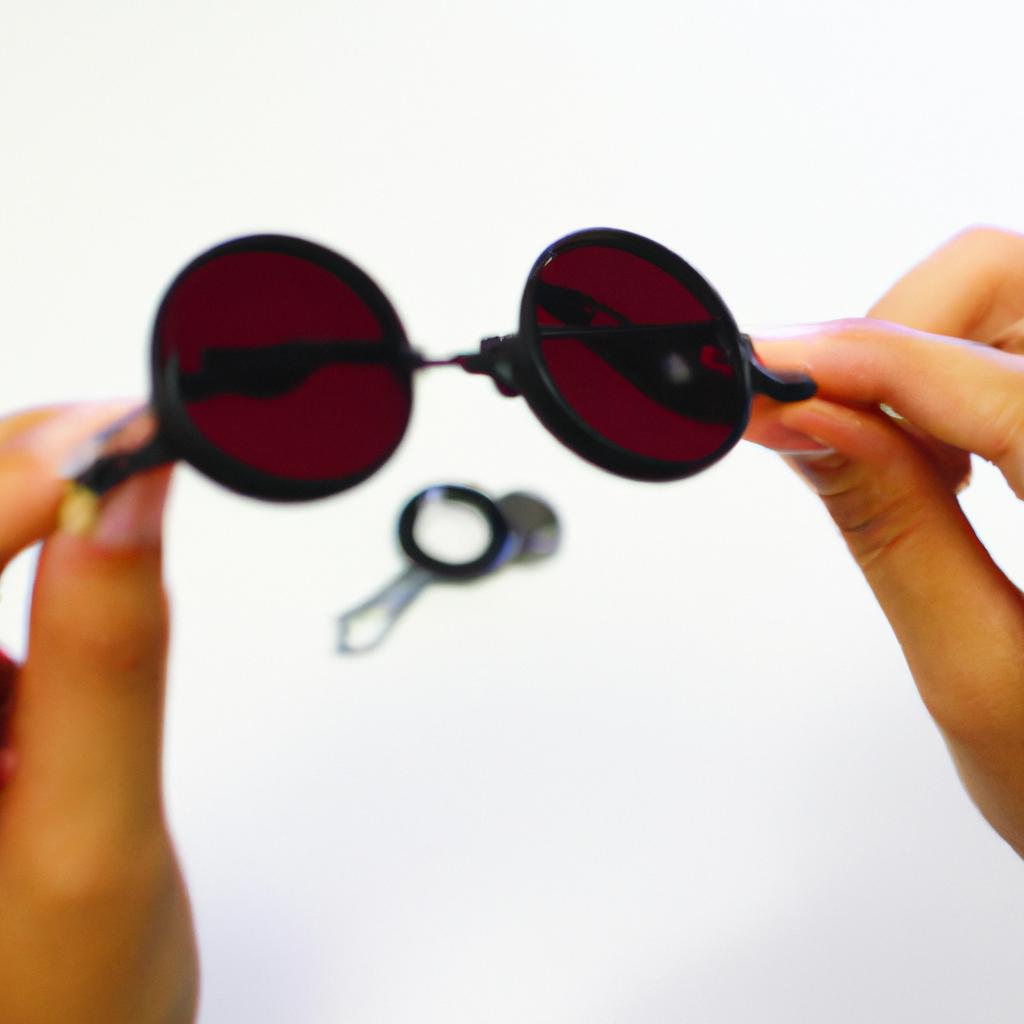Optical Lenses in Sunglasses: A Comprehensive Guide

Optical lenses play a significant role in enhancing visual clarity and protecting the eyes from harmful ultraviolet (UV) radiation. Sunglasses, as an essential accessory for many individuals, rely on these optical lenses to provide not only style but also optimal vision while outdoors. For instance, consider a hypothetical scenario where an individual experiences discomfort and eye strain due to prolonged exposure to direct sunlight. By wearing sunglasses with appropriate optical lenses, this person could potentially alleviate their symptoms by reducing glare and filtering out harmful UV rays.
In order to fully understand the importance of optical lenses in sunglasses, it is necessary to delve into the various aspects that contribute to their functionality. This comprehensive guide aims to shed light on different types of optical lenses commonly used in sunglasses, including polarized lenses, photochromic lenses, and mirrored lenses. Additionally, it will explore the factors influencing lens selection such as prescription requirements and specific activities or environments one may be exposed to. Understanding these intricacies enables consumers to make informed decisions when choosing sunglasses that not only match their personal preferences but also meet their unique visual needs.
Through examining the characteristics and benefits associated with each type of optical lens, readers will gain valuable insights into how they can optimize their sun protection and visual experience simultaneously. Furthermore, this guide will provide practical tips on proper care and maintenance of sunglasses, as well as suggestions for selecting frames that complement different face shapes and personal styles. By equipping individuals with this knowledge, they will be able to make educated choices when purchasing sunglasses that suit their specific requirements.
In summary, optical lenses are a crucial component of sunglasses, serving the dual purpose of enhancing visual clarity and protecting the eyes from harmful UV radiation. This guide aims to provide readers with a comprehensive understanding of different types of lenses available in sunglasses, factors influencing lens selection, and tips for proper care and maintenance. Armed with this information, individuals can confidently select sunglasses that not only offer optimal sun protection but also align with their style preferences and visual needs.
Types of Optical Lenses in Sunglasses
Imagine a scenario where you are planning to spend your summer vacation at a sunny beach destination. You want to make sure that you protect your eyes from harmful UV rays and glare while still enjoying the beautiful scenery. This is where optical lenses in sunglasses play a crucial role, providing both protection and visual clarity. In this section, we will explore different types of optical lenses commonly used in sunglasses.
-
Polarized Lenses: These lenses have gained popularity due to their ability to reduce glare caused by reflected light from flat surfaces such as water or snow. By filtering out horizontal light waves, polarized lenses enhance visual comfort and improve contrast sensitivity. They are particularly beneficial for activities like boating, fishing, or skiing.
-
Photochromic Lenses: Known for their adaptive nature, photochromic lenses darken when exposed to sunlight and lighten when indoors or in low light conditions. This automatic adjustment allows wearers to experience optimal vision throughout the day without having to switch between multiple pairs of glasses. Photochromic lenses are ideal for those who frequently transition between indoor and outdoor environments.
-
Mirrored Lenses: Mirrored lenses offer additional reflective properties that help minimize the amount of light passing through the lens. These highly reflective coatings provide excellent sun protection by reducing visible light transmission levels. Moreover, they come in various colors which add style and aesthetic appeal to sunglasses.
-
Gradient Lenses: Gradient lenses feature a gradual tinting effect that transitions from darker on top (near the browline) to lighter towards the bottom (at the cheeks). This design allows for comfortable viewing of objects at varying distances – clear vision above with reduced brightness below. Gradient lenses are favored by fashion-conscious individuals seeking both eye protection and a trendy look.
Consider how these four types of optical lenses can greatly enhance your overall sunglass-wearing experience:
| Lens Type | Benefits |
|---|---|
| Polarized | Reduced glare, enhanced contrast |
| Photochromic | Adaptive to lighting conditions |
| Mirrored | Maximum sun protection, stylish appearance |
| Gradient | Comfortable viewing at different distances |
In summary, the selection of optical lenses in sunglasses is a crucial decision that can greatly impact your visual comfort and eye health. Each type of lens offers unique benefits suited for specific activities or personal preferences. Understanding these options empowers you to make an informed choice when purchasing sunglasses that best suit your needs.
Moving forward, let’s delve into the factors to consider when choosing optical lenses, ensuring you select the most suitable pair for your individual requirements.
Factors to Consider When Choosing Optical Lenses
Imagine a scenario where you are planning to purchase a new pair of sunglasses. As you browse through the options, it becomes evident that there is more to consider than just style and design. The type of optical lenses in your sunglasses play a crucial role in not only enhancing your visual experience but also protecting your eyes from harmful UV radiation. In this section, we will explore the factors that should be taken into account when choosing optical lenses for your sunglasses.
Firstly, it is essential to assess the level of protection provided by the lenses against ultraviolet (UV) rays. Exposure to these rays can lead to various eye conditions such as cataracts and macular degeneration. Look for sunglasses with lenses that have built-in UV filters or coatings, preferably blocking 100% of both UVA and UVB rays.
Secondly, consider the lens material which affects durability, weight, and clarity of vision. Common lens materials include glass, plastic, polycarbonate, and Trivex. Glass lenses offer exceptional optical quality but tend to be heavier compared to other materials. Plastic lenses are lighter but may lack impact resistance. Polycarbonate and Trivex lenses are highly impact-resistant while providing good optical performance.
In addition to UV protection and lens material, another factor to contemplate is the lens tint or color. Different tints serve varying purposes; for instance:
- Gray tints provide neutral color perception.
- Brown/amber tints enhance contrast and depth perception.
- Yellow tints improve visibility in low-light conditions.
- Mirrored coatings reduce glare by reflecting excess light.
Consideration must also be given to any specific prescription requirements or additional features like polarization or photochromic capabilities tailored towards individual needs.
To summarize, when selecting optical lenses for your sunglasses:
- Ensure they offer adequate UV protection
- Choose an appropriate lens material considering durability and weight
- Opt for a lens tint that aligns with your visual needs
- Consider any prescription requirements or additional features
By keeping these factors in mind, you can make an informed decision when purchasing sunglasses and ensure both comfort and protection for your eyes.
Benefits of Optical Lenses in Sunglasses
Optical Lenses in Sunglasses: A Comprehensive Guide
In the previous section, we discussed the various factors that should be taken into consideration when choosing optical lenses for sunglasses. To further emphasize the importance of these factors, let us consider a hypothetical scenario involving two individuals with different lens preferences.
Imagine Sarah and John both need prescription sunglasses but have varying needs. Sarah enjoys spending time outdoors and often participates in outdoor activities such as hiking and cycling. She requires lenses that provide excellent UV protection and minimize glare from sunlight. On the other hand, John predominantly uses his sunglasses for driving purposes. He prioritizes lenses that enhance color perception and reduce eye strain caused by intense light conditions.
To guide you through this decision-making process, here are four key factors you should keep in mind:
- Lens Material:
- Polycarbonate: lightweight and impact-resistant
- Trivex: provides exceptional clarity while being thin and lightweight
- High-index plastic: offers thinner profile for higher prescriptions
- Glass: superior optics but heavier and less impact-resistant than other materials
- Lens Coatings:
- Anti-scratch coating: protects against surface damage
- Anti-glare coating: reduces reflections for enhanced vision
- Polarized coating: minimizes horizontal glare from surfaces like water or snow
- Mirror coating: reflects light away from the eyes, ideal for bright environments
-
Prescription Accuracy:
Ensure accurate measurements to avoid distorted vision or discomfort due to improper lens alignment. -
Tint Options:
Choose tints suitable for your lifestyle and intended use.
- Grey tint is versatile, reducing brightness without distorting colors.
- Brown tint enhances contrast, making it ideal for sports or outdoor activities.
- Green tint provides good color balance while reducing eyestrain in bright conditions.
- Yellow/amber tint improves depth perception in low-light conditions.
By considering these factors carefully, you can select optical lenses that best suit your specific needs and lifestyle. Remember, the right choice of optical lenses can significantly enhance visual comfort and overall satisfaction with your sunglasses.
Next, we will explore how optical lenses enhance visual comfort in greater detail. Let’s delve into the ways these lenses optimize vision for a more enjoyable experience outdoors.
How Optical Lenses Enhance Visual Comfort
Enhancing Visual Comfort with Optical Lenses in Sunglasses
Imagine a sunny day at the beach, where you’re relaxing under the shade of an umbrella and enjoying your favorite book. As you glance up to admire the crystal-clear ocean, you put on your sunglasses equipped with optical lenses. Instantly, you notice how much more comfortable and soothing the view becomes. In this section, we will explore how optical lenses enhance visual comfort by reducing eye strain and glare.
Firstly, optical lenses in sunglasses provide superior protection against harmful ultraviolet (UV) rays emitted by the sun. Excessive UV exposure can lead to various eye conditions such as cataracts or macular degeneration. By filtering out these damaging rays, optical lenses safeguard your eyes from potential long-term harm.
Secondly, these specialized lenses effectively reduce eye strain caused by extended periods of outdoor activities or screen usage. The unique design of optical lenses optimizes visual acuity while minimizing distortion and fatigue. This allows for prolonged usage without experiencing discomfort or headaches often associated with poorly designed eyewear.
To further emphasize the benefits of using sunglasses with optical lenses, consider the following bullet points:
- Minimize Glare: Optical lenses significantly decrease glare from reflective surfaces like water or snow.
- Improve Color Perception: These lenses enhance color contrast and improve overall perception of depth and detail.
- Increase Visual Clarity: With reduced aberrations and optimized focus zones, optical lenses offer sharper vision in various lighting conditions.
- Enhance Eye Health: By protecting against harmful blue light and reducing eye strain, they promote healthier eyesight in the long run.
| Benefits of Optical Lenses | |
|---|---|
| Minimize Glare | ✔ |
| Improve Color Perception | ✔ |
| Increase Visual Clarity | ✔ |
| Enhance Eye Health | ✔ |
In summary, wearing sunglasses equipped with optical lenses not only shields your eyes from harmful UV rays but also enhances visual comfort. These lenses effectively reduce eye strain, minimize glare, improve color perception, increase visual clarity, and promote overall eye health.
Transitioning into the subsequent section about “Common Lens Coatings for Sunglasses,” we will explore additional features that can elevate the performance of optical lenses in sunglasses.
Common Lens Coatings for Sunglasses
Section H2: Common Lens Coatings for Sunglasses
Transitioning from our discussion on how optical lenses enhance visual comfort, let us now explore the various lens coatings commonly used in sunglasses. To illustrate their importance and effectiveness, consider this scenario: Imagine you are enjoying a sunny day at the beach with your favorite pair of sunglasses. Without any lens coating, you may find yourself constantly squinting due to excessive glare caused by sunlight reflecting off the water’s surface. However, with the appropriate lens coatings, your vision would be significantly improved, allowing you to enjoy the scenery without discomfort.
Lens coatings play a crucial role in enhancing both visual performance and eye protection when wearing sunglasses. These coatings are applied to the lenses during manufacturing processes and offer several benefits:
- Anti-reflective (AR) coating: This coating reduces glare by minimizing light reflections that bounce off the front and back surfaces of the lenses. It improves contrast perception and clarity while reducing eye strain.
- Scratch-resistant coating: As its name suggests, this protective layer helps prevent scratches on the lens surface caused by accidental drops or contact with abrasive materials.
- UV protection coating: Essential for protecting your eyes against harmful ultraviolet (UV) rays emitted by the sun, this coating blocks UVA and UVB radiation from reaching your eyes.
- Hydrophobic coating: Applied to lenses as a water-repellent layer, hydrophobic coatings minimize smudges from fingerprints, dust particles, or raindrops.
Table 1 below summarizes these common lens coatings along with their respective benefits:
| Coating | Benefits |
|---|---|
| AR | Reduced glare; improved contrast perception; minimized eye strain |
| Scratch-resistant | Protection against scratches caused by accidents or abrasion |
| UV protection | Shielding against harmful UVA and UVB rays |
| Hydrophobic | Water resistance; reduction of smudges |
By selecting sunglasses with the appropriate lens coatings, you can optimize your visual experience while simultaneously safeguarding your eyes from potential harm.
Transitioning into our next section on understanding prescription lenses in sunglasses, it is important to recognize that personalized vision correction plays a significant role in eyewear. Understanding how prescription lenses are incorporated into sunglasses will further enhance your overall visual comfort and clarity.
Understanding Prescription Lenses in Sunglasses
Building upon the importance of lens coatings, understanding prescription lenses in sunglasses is crucial for those requiring corrective vision. Prescription sunglasses provide both style and functionality, catering to individuals with specific visual needs. This section will delve into the various aspects of prescription lenses used in sunglasses, highlighting their benefits and considerations.
Prescription lenses offer a tailored solution for individuals who require vision correction while still enjoying the benefits of sunglasses. To illustrate this further, let’s consider the case study of Sarah, an avid outdoor enthusiast who also wears glasses. Sarah finds it challenging to engage in her favorite activities under bright sunlight due to sensitivity caused by her uncorrected vision. However, with prescription sunglasses that are equipped with specialized lenses, she can now fully immerse herself in these activities without compromising on visual clarity.
When selecting prescription lenses for sunglasses, several factors should be taken into account:
- Lens Material: Different materials such as polycarbonate or high-index plastic offer varying degrees of impact resistance and thickness options.
- Lens Design: Options include single-vision lenses for either nearsightedness or farsightedness correction, bifocal lenses combining distance and close-up corrections, or progressive lenses providing graduated vision correction.
- Tinting Options: Choosing a tint color suitable for one’s lifestyle and preferences plays a significant role in optimizing visual comfort under different lighting conditions.
- UV Protection: Ensuring adequate protection from harmful ultraviolet (UV) rays is essential to safeguard eye health over time.
| Lens Type | Key Features | Benefits |
|---|---|---|
| Polycarbonate | Lightweight and impact-resistant | Suitable for active lifestyles |
| High-Index Plastic | Thin and lightweight | Ideal for stronger prescriptions |
| Photochromic | Light-sensitive, tint adjusts to sunlight | Convenient transition between indoor and outdoor environments |
| Polarized | Reduces glare from reflective surfaces | Enhanced visual comfort in bright conditions |
In conclusion, prescription lenses in sunglasses cater to individuals seeking both vision correction and sun protection. By considering the lens material, design, tinting options, and UV protection capabilities, one can find a suitable pair of prescription sunglasses that seamlessly blend style with functionality. Whether it’s engaging in outdoor activities or simply enjoying everyday life under the sun, prescription sunglasses empower individuals like Sarah to experience optimal vision without compromising on personal style.



